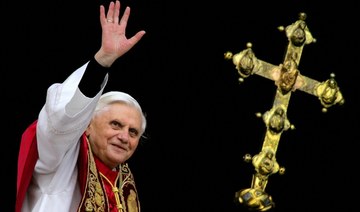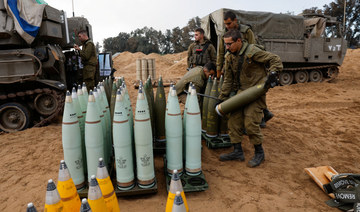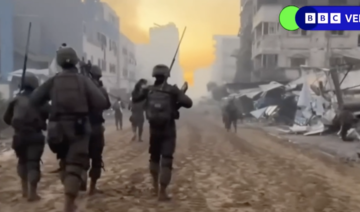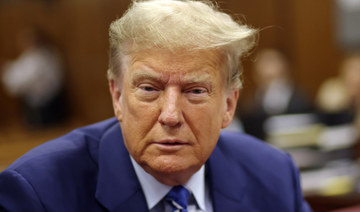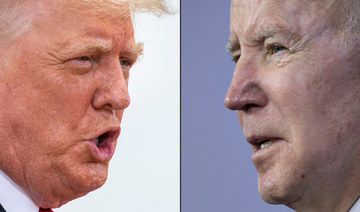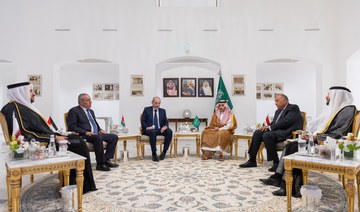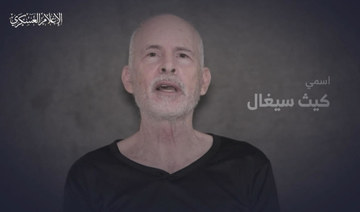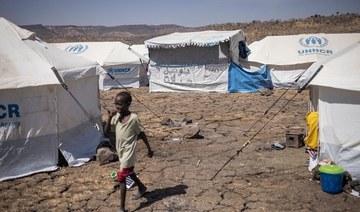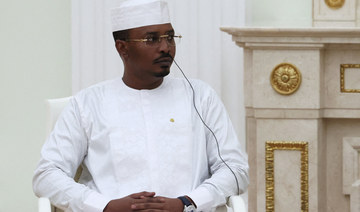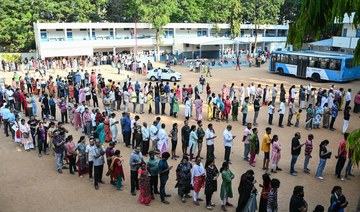VATICAN CITY: Bells tolled Thursday for the funeral of Pope Emeritus Benedict XVI, the German theologian who made history by retiring, as thousands of mourners packed St. Peter’s Square for a rare requiem Mass of a dead pontiff presided over by a living one.
The faithful applauded as pallbearers carried Benedict’s cypress coffin out of the fog-shrouded St. Peter’s Basilica and rested it before the altar. With red-robed clergy looking on, Benedict’s longtime secretary, Archbishop Georg Gaenswein, bent down and kissed a book of the Gospels that was left open on the coffin.
Heads of state and royalty, clergy from around the world and thousands of regular people flocked to the Vatican, despite Benedict’s requests for simplicity and official efforts to keep the first funeral for an pope emeritus in modern times low-key.
Many hailed from Benedict’s native Bavaria and donned traditional dress, including boiled wool coats to guard against the morning chill.
“We came to pay homage to Benedict and wanted to be here today to say goodbye,” said Raymond Mainar, who traveled from a small village east of Munich for the funeral. “He was a very good pope.”
The former Joseph Ratzinger, who died Dec. 31 at age 95, is considered one of the 20th century’s greatest theologians and spent his lifetime upholding church doctrine. But he will go down in history for a singular, revolutionary act that changed the future of the papacy: He retired, the first pope in six centuries to do so.
Pope Francis has praised Benedict’s courage to step aside, saying it “opened the door” to other popes doing the same. Francis, for his part, recently said he has already left written instructions outlining the conditions in which he too would resign.
Francis was presiding over the funeral, which authorities estimated some 100,000 would attend, higher than an original estimate of 60,000, Italian media reported, citing police security plans.
Only Italy and Germany were invited to send official delegations, but other heads of state and government took the Vatican up on its offer and come in their “private capacity.” They included several other heads of state, at least four prime ministers and two delegations of royal representatives.
Matteo Colonna, a 20-year-old seminarian from Teramo, Italy, said he attended in part because of the historic nature of the funeral — but it also had personal resonance for him.
“The first spark of my vocation started under the pontificate of Benedict, but then it became even stronger under Pope Francis,” Colonna said, while sitting in prayer in St. Peter’s Square ahead of the funeral. “I see a continuity between these two popes and the fact that today Francis is celebrating the funeral in Benedict’s memory is a historical event.”
Early Thursday the Vatican released the official history of Benedict’s life, a short document in Latin that was placed in a metal cylinder in his coffin )before it was sealed, along with the coins and medallions minted during his papacy and his pallium stoles.
The document gave ample attention to Benedict’s historic resignation and referred to him as “pope emeritus,” citing verbatim the Latin words he uttered on Feb. 11, 2013, when he announced he would retire.
The document, known as a “rogito” or deed, also cited his theological and papal legacy, including his outreach to Anglicans and Jews and his efforts to combat clergy sexual abuse “continually calling the church to conversion, prayer, penance and purification.”
The funeral ritual itself is modeled on the code used for dead popes but with some modifications given Benedict was not a reigning pontiff when he died.
After the Mass, Benedict’s cypress coffin was to be placed inside a zinc one, then an outer oak casket before being entombed in the crypt in the grottos underneath St. Peter’s Basilica that once held the tomb of St. John Paul II before it was moved upstairs.
While the ritual is novel, it does have some precedent: In 1802, Pope Pius VII presided over the funeral in St. Peter’s of his predecessor, Pius VI, who had died in exile in France in 1799 as a prisoner of Napoleon.
Some 200,000 paid tribute to Benedict during three days of public viewing in the basilica, with one of the last, Friar Rosario Vitale, spending an hour praying by his body. He said Benedict had given him a special dispensation to begin the process of becoming a priest, which was required because of a physical disability.
“So today I came here to pray on his tomb, on his body and to say ‘thank you’ for my future priesthood, for my ministry,” he said.
Benedict never intended his retirement to last as long as it did — at nearly 10 years it was longer than his eight-year pontificate. And the unprecedented situation of a retired pope living alongside a reigning one prompted calls for protocols to guide future popes emeritus to prevent any confusion about who is really in charge.
During St. John Paul II’s quarter-century as pope, Ratzinger spearheaded a crackdown on dissent as prefect of the Congregation for the Doctrine of the Faith, taking action against the left-leaning liberation theology that spread in Latin America in the 1970s and against dissenting theologians and nuns who didn’t toe the Vatican’s hard line on matters like sexual morals.
His legacy was marred by the clergy sexual abuse scandal, even though he recognized earlier than most the “filth” of priests who raped children, and actually laid the groundwork for the Holy See to punish them.
As cardinal and pope, he passed sweeping church legislation that resulted in 848 priests being defrocked from 2004-2014, roughly his pontificate with a year on either end. But abuse survivors still held him responsible for the crisis, for failing to sanction any bishop who moved abusers around and identifying him as embodying the clerical system that long protected the institution over victims.
A group representing German clergy abuse survivors called on German officials attending Benedict’s funeral to demand more action from the Vatican on sexual abuse. Eckiger Tisch asked German leaders to demand that Francis issue a “universal church law” stipulating zero tolerance in dealing with abuse by clergy.
“Any celebration that marks the life of abuse enablers like Benedict must end,” said the main US abuse survivor group SNAP.
Thousands pour into St. Peter’s for funeral of Benedict XVI
https://arab.news/76dth
Thousands pour into St. Peter’s for funeral of Benedict XVI
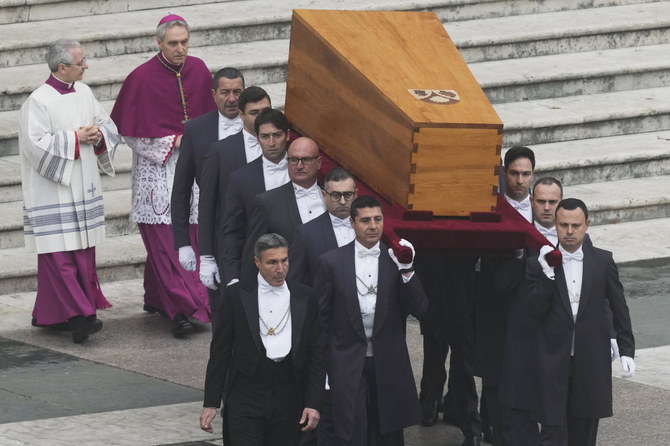
- Benedict, a world renowned theologian, died at 95 on Saturday in a monastery within the Vatican gardens where he moved after bec
- The funeral ritual itself is modeled on the code used for dead popes but with some modifications given Benedict was not a reigning pontiff when he died
Some US officials say in internal memo Israel may be violating international law in Gaza
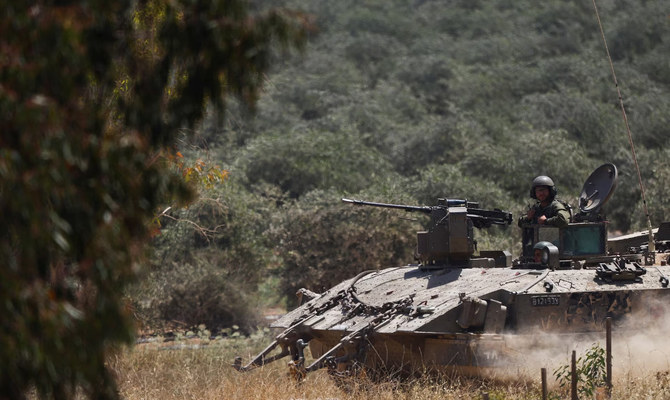
- The submissions to the memo provide the most extensive picture to date of the divisions inside the State Department over whether Israel might be violating international humanitarian law in Gaza
WASHINGTON: Some senior US officials have advised Secretary of State Antony Blinken that they do not find “credible or reliable” Israel’s assurances that it is using US-supplied weapons in accordance with international humanitarian law, according to an internal State Department memo reviewed by Reuters.
Other officials upheld support for Israel’s representation.
Under a National Security Memorandum (NSM) issued by President Joe Biden in February, Blinken must report to Congress by May 8 whether he finds credible Israel’s assurances that its use of US weapons does not violate US or international law.
By March 24, at least seven State Department bureaus had sent in their contributions to an initial “options memo” to Blinken. Parts of the memo, which has not been previously reported, were classified.
The submissions to the memo provide the most extensive picture to date of the divisions inside the State Department over whether Israel might be violating international humanitarian law in Gaza.
“Some components in the department favored accepting Israel’s assurances, some favored rejecting them and some took no position,” a US official said.
A joint submission from four bureaus — Democracy Human Rights & Labor; Population, Refugees and Migration; Global Criminal Justice and International Organization Affairs – raised “serious concern over non-compliance” with international humanitarian law during Israel’s prosecution of the Gaza war.
The assessment from the four bureaus said Israel’s assurances were “neither credible nor reliable.” It cited eight examples of Israeli military actions that the officials said raise “serious questions” about potential violations of international humanitarian law.
These included repeatedly striking protected sites and civilian infrastructure; “unconscionably high levels of civilian harm to military advantage“; taking little action to investigate violations or to hold to account those responsible for significant civilian harm and “killing humanitarian workers and journalists at an unprecedented rate.”
The assessment from the four bureaus also cited 11 instances of Israeli military actions the officials said “arbitrarily restrict humanitarian aid,” including rejecting entire trucks of aid due to a single “dual-use” item, “artificial” limitations on inspections as well as repeated attacks on humanitarian sites that should not be hit.
Another submission to the memo reviewed by Reuters, from the bureau of Political and Military Affairs, which deals with US military assistance and arms transfers, warned Blinken that suspending US weapons would limit Israel’s ability to meet potential threats outside its airspace and require Washington to re-evaluate “all ongoing and future sales to other countries in the region.”
Any suspension of US arms sales would invite “provocations” by Iran and aligned militias, the bureau said in its submission, illustrating the push-and-pull inside the department as it prepares to report to Congress.
The submission did not directly address Israel’s assurances.
Inputs to the memo from the Office of the Special Envoy to Monitor and Combat Antisemitism and US ambassador to Israel Jack Lew said they assessed Israel’s assurances as credible and reliable, a second US official told Reuters.
The State Department’s legal bureau, known as the Office of the Legal Adviser, “did not take a substantive position” on the credibility of Israel’s assurances, a source familiar with the matter said.
State Department spokesperson Matthew Miller said the agency doesn’t comment on leaked documents.
“On complex issues, the Secretary often hears a diverse range of views from within the Department, and he takes all of those views into consideration,” Miller said.
MAY 8 REPORT TO CONGRESS
When asked about the memo, an Israeli official said: “Israel is fully committed to its commitments and their implementation, among them the assurances given to the US government.”
The White House did not respond to a request for comment.
Biden administration officials repeatedly have said they have not found Israel in violation of international law.
Blinken has seen all of the bureau assessments about Israel’s pledges, the second US official said.
Matthew Miller on March 25 said the department received the pledges. However, the State Department is not expected to render its complete assessment of credibility until the May 8 report to Congress.
Further deliberations between the department’s bureaus are underway ahead of the report’s deadline, the US official said.
USAID also provided input to the memo. “The killing of nearly 32,000 people, of which the GOI (Government of Israel) itself assesses roughly two-thirds are civilian, may well amount to a violation of the international humanitarian law requirement,” USAID officials wrote in the submission.
USAID does not comment on leaked documents, a USAID spokesperson said.
The warnings about Israel’s possible breaches of international humanitarian law made by some senior State Department officials come as Israel is vowing to launch a military offensive into Rafah, the southern-most pocket of the Gaza Strip that is home to over a million people displaced by the war, despite repeated warnings from Washington not to do so.
Israel’s military conduct has come under increasing scrutiny as its forces have killed 34,000 Palestinians in Gaza, according to the enclave’s health authorities, most of them women and children.
Israel’s assault was launched in response to the Hamas attack on Israel on Oct. 7, in which Israel says 1,200 people were killed and 250 others taken hostage.
The National Security Memorandum was issued in early February after Democratic lawmakers began questioning whether Israel was abiding by international law.
The memorandum imposed no new legal requirements but asked the State Department to demand written assurances from countries receiving US-funded weapons that they are not violating international humanitarian law or blocking US humanitarian assistance.
It also required the administration to submit an annual report to Congress to assess whether countries are adhering to international law and not impeding the flow of humanitarian aid.
If Israel’s assurances are called into question, Biden would have the option to “remediate” the situation through actions ranging from seeking fresh assurances to suspending further US weapons transfers, according to the memorandum.
Biden can suspend or put conditions on US weapons transfers at any time.
He has so far resisted calls from rights groups, left-leaning Democrats and Arab American groups to do so.
But earlier this month he threatened for the first time to put conditions on the transfer of US weapons to Israel, if it does not take concrete steps to improve the dire humanitarian situation in Gaza.
President Joe Biden says he’s ‘happy to debate’ Donald Trump. Trump says he’s ready to go
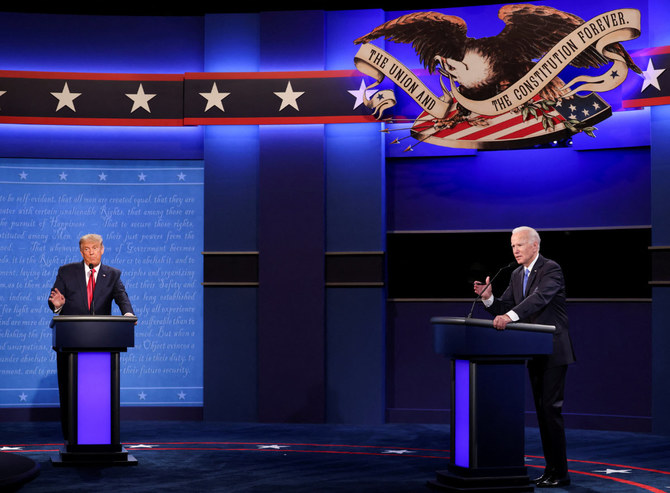
- Biden had previously been vague, saying in March that whether he debated Trump “depends on his behavior”
- During the 2020 general election, Biden was notably irritated by Trump’s antics in the chaotic first debate
NEW YORK: President Joe Biden said Friday that he is willing to debate his presumptive Republican opponent, Donald Trump, later this fall – his most definitive comment yet on the issue.
Trump said he was ready, though he questioned Bidens’s willingness.
Biden’s comment came during an interview with the Sirius XM radio host Howard Stern, who asked him whether he would participate in debates against Trump.
“I am, somewhere. I don’t know when,” Biden said. “But I’m happy to debate him.”
Until now, Biden’s reelection campaign had declined to commit to participating in the debates, a hallmark of every general election presidential campaign since 1976.
Biden himself had also been vague, saying in March that whether he debated Trump “depends on his behavior.” The two men debated twice during the 2020 general election — a campaign year constrained significantly by COVID-19 restrictions — and Biden was notably irritated by Trump’s antics in the chaotic first debate that year.
“Will you shut up?” Biden told Trump at one point during the first debate.
Trump campaign officials have said for some time that the former president is prepared to debate Biden anytime, and Chris LaCivita, Trump campaign senior adviser, quickly responded to Biden’s remarks on the social media site X: “OK let’s set it up!”
Later Friday, Trump reacted to Biden’s new public willingness to debate by saying “everyone knows he doesn’t really mean it” but suggested either next Monday evening, Tuesday evening or Wednesday evening, when Trump will be campaigning in Michigan. The former president is suggesting evenings because he is otherwise attending proceedings for his hush money criminal trial in New York.
Trump is required to be in court every day but Wednesdays. In a statement on his own social media platform, Trump also challenged Biden to debate at the Manhattan courthouse on Friday night, since both men were in New York at the same time. Biden has since returned to Washington.
Yet Friday is also Melania Trump’s birthday, and the former president had already said earlier in the day that he was flying back to Florida to spend the day with his wife once his trial had wrapped for the day.
As Trump left court for the day in New York on Friday afternoon, he repeated his challenge and said: “We’re ready. Just tell me where. I will do it at the White House. That would be very comfortable, actually.”
Trump did not participate in any of the Republican primary debates this cycle.
The Commission on Presidential Debates has already announced the dates and locations for the three general election debates between the presidential candidates: Sept. 16 in San Marcos, Texas; Oct. 1 in Petersburg, Virginia; and Oct. 9 in Salt Lake City. The lone vice presidential debate is slated for Sept. 25 in Easton, Pennsylvania.
A dozen news organizations, including The Associated Press, wrote to the Biden and Trump campaigns earlier this month to urge both candidates to participate in the debates.
Biden engages in relatively fewer press interviews than his predecessors, and his aides tend to choose outlets and media avenues outside the traditional press corps that covers the president in Washington. His interview with Stern on Friday, which ran well over an hour, took on an informal and introspective tone and spanned topics that included Biden’s upbringing, family, and his favorite president (Thomas Jefferson, Biden said).
The interview also occurred the day after The New York Times issued a statement criticizing Biden for shunning formal interviews and conducting fewer news conferences than his predecessors. The newspaper said that its publisher, A.G. Sulzberger, has urged senior Biden officials to agree to presidential interviews not just with the Times but with other news outlets.
Still, the timing of the Stern interview was coincidental; a person familiar with the plans said the White House has been working with the Sirius XM host for weeks to arrange the conversation. The person was granted anonymity to discuss internal planning processes.
Less the “shock jock” of old, Stern still commands a loyal audience. And he’s become known for his conversational interviewing skills. He can turn talks with celebrities into revealing discussions, often by asking things others might be afraid to, but not in confrontational ways.
Gaza war casts shadow over White House correspondents’ dinner
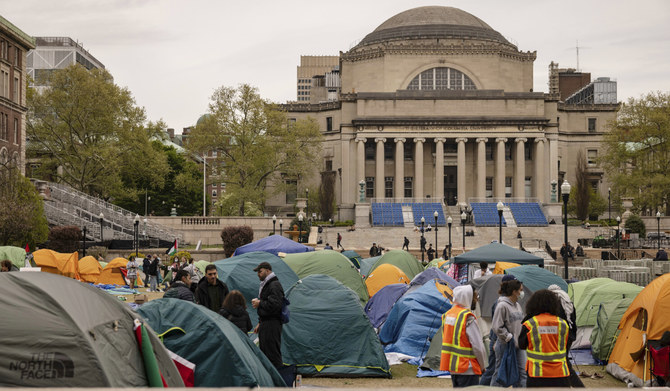
- The gala dinner and a surrounding series of society events are taking place as the Gaza protest movement has been spreading to colleges across the country, and as police crackdowns on some campuses have led to hundreds of arrests
WASHINGTON: The White House Correspondents’ Association dinner, which annually brings reporters, politicians and a glitzy array of celebrities together in a mostly lighthearted affair, will take place Saturday under very different circumstances, including a call for a boycott by Palestinian journalists.
With President Joe Biden heading a long list of VIP guests, more than two dozen Palestinian journalists this week issued an open letter urging their American colleagues to boycott the dinner.
“You have a unique responsibility to speak truth to power and uphold journalistic integrity,” said the letter. “It is unacceptable to stay silent out of fear or professional concern while journalists in Gaza continue to be detained, tortured, and killed for doing our jobs.”
According to the New York-based Committee for the Protection of Journalists (CPJ), at least 97 journalists — including 92 Palestinians — have been killed since war erupted on October 7 with Hamas’s invasion of southern Israel. At least 16 others have been wounded.
In addition to the boycott call, an anti-war coalition is planning a demonstration not far from the Washington Hilton hotel where the dinner is to take place.
The anti-war group Code Pink, part of the coalition, said it planned to “shut down” the dinner to protest “the complicity of the Biden administration in the targeting and killing of Palestinian journalists by the Israeli military.”
It said its action would be “nonviolent” but offered no details.
For months, Biden’s every move has been shadowed by protesters angry over US support for the Israeli military offensive in Gaza. He has been met by shouts of “Genocide Joe” and noisy calls for an immediate ceasefire in Gaza.
The gala dinner and a surrounding series of society events are taking place as the Gaza protest movement has been spreading to colleges across the country, and as police crackdowns on some campuses have led to hundreds of arrests.
At the dinner, in keeping with longstanding tradition — interrupted during the Donald Trump years — Biden will sit on the dais keeping a steady smile on his face as a guest comedian rips into him.
This year it will be Colin Jost, a longtime writer and actor with NBC’s “Saturday Night Live,” who seeks to entertain the crowd of VIPs in their tuxedos and flowing evening gowns. (Jost’s wife, actress Scarlett Johansson, is expected to be there.)
The 81-year-old US president, also in keeping with tradition, will then deliver a speech, sure to include some self-mockery, some ribbing of the press and, no doubt, some sharp-elbowed jabs at Trump, his presumptive opponent in November’s presidential election.
The annual dinner has been organized since 1920 by the influential White House Correspondents’ Association, which honors top reporters and awards journalism scholarships.
Last year, 2,600 people attended.
The association declined an AFP request to comment on the boycott call and the planned demonstration.
US troops to leave Chad in second African state withdrawal
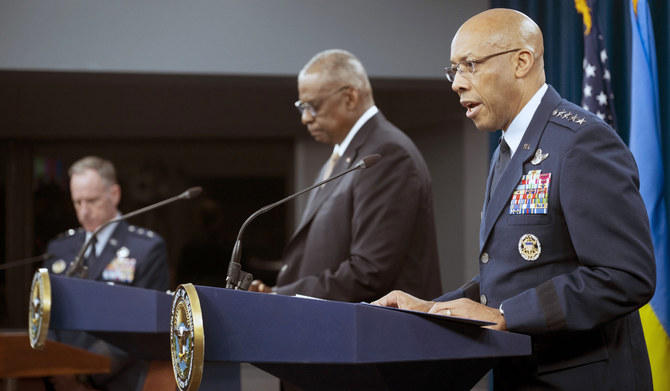
- It is important to stress that this withdrawal in no way signifies a break in cooperation between the two countries in the fight against terrorism
WASHINGTON: The US will withdraw some troops from Chad, the Pentagon has said, days after Washington agreed to move forces out of neighboring Niger.
The US has approximately 100 troops stationed in Chad as part of its strategy to combat extremism in West Africa.
“USAFRICOM is currently planning to reposition some US military forces from Chad, a portion of which were already scheduled to depart,” Pentagon press secretary Maj. Gen. Pat Ryder told a news conference, referring to the US Africa Command.
“This is a temporary step as part of an ongoing review of our security cooperation, which will resume after Chad’s May 6 presidential election.”
The withdrawal of about 75 US Army Special Forces personnel is scheduled to begin this weekend and be completed within days unless there are last-minute diplomatic developments, the New York Times reported, citing US officials.
Chad’s air force chief had ordered the US military this month to halt activities at an air base near the capital N’Djamena, according to a letter sent to the transitional government.
He said he had asked the US military to provide documents “justifying its presence at the Adji Kossei Air Base” but had not received any.
US troops at the Adji Kossei military base train anti-terrorism special forces and an elite unit of the Chadian army to combat the Nigerian jihadist group Boko Haram.
“The presence of American forces in Chad was initially motivated by a common commitment to the fight against terrorism, an objective shared between the two nations,” a Chadian government spokesperson said.
“However, the Chadian general staff has expressed concerns about this presence,” said Abderaman Koulamallah. In recognition of the concerns expressed, the US government has decided to temporarily withdraw its forces from Chad.
“It is important to stress that this withdrawal does not in any way signal a break in cooperation between the two countries in the fight against terrorism.
“Further discussions will take place to explore the possibility of the return of US forces in the case of a specific bilateral agreement between the two nations.”
Neighboring Niger is also a linchpin in the US and French strategy to combat jihadists in the region.
But Niger’s ruling military junta said in March that it was ending a military cooperation agreement with Washington, claiming it had been imposed and the US troop presence was illegal.
Washington this week began discussions with Niger on withdrawing the more than 1,000 US personnel in the country, which is also home to a $100-million American drone base.
The US will “continue to explore options on how we can ensure that we’re able to continue to address potential terrorist threats” in the wake of the withdrawal, Ryder said this week following the announcement of the US pull-out from Niger.
General Mahamat Idriss Deby Itno seized the presidency of Chad in a 2021 coup after the death of his father, Idriss Deby Itno, who had ruled the Sahel country with an iron fist for more than three decades.
He announced in March his candidacy in the upcoming presidential election that has seen opposition candidates banned from running, and his main rival Yaya Dillo Djerou shot dead in an army assault on his party headquarters.
Voter turnout slumps, Modi ‘wave’ missing from India’s 2024 polls
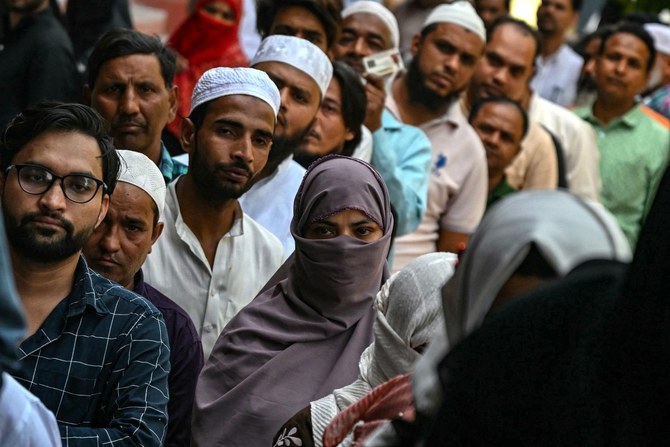
- India’s general election started on April 19 and is taking place in seven phases till June 1
- Voters are battling extreme temperatures as parts of India gripped by heatwave
NEW DELHI: Voter numbers have slumped in the first and second phase of India’s general election, with experts saying that the “wave” of enthusiasm that brought incumbent Prime Minister Narendra Modi to power in 2014 was no longer present in the ongoing polls.
More than 968 million people have been registered to vote in the world’s biggest general election, in which Modi and his Hindu nationalist Bharatiya Janata Party are aiming for a rare third consecutive term in power.
The first phase of voting was on April 19 and the polls are taking place over six weeks, with results expected on June 4.
India has a total of 28 states and eight federally governed territories. Some regions complete the process on a single day, while others spread it out over several phases.
The second phase was on April 26 and the other voting dates will be May 7, May 13, May 20, May 25 and June 1.
Friday’s turnout was estimated by the Election Commission of India at 61 percent — compared with 68 percent in the second phase five years ago. In the first phase, it was 65 percent against nearly 70 percent in 2019.
The lower turnout showed “apathy toward politics,” D. Dhanuraj, chairman of the Kerala-based Center for Public Policy Research, told Arab News.
“I think it is clear now that there is no wave in favor of any party as such. In 2014, there was a wave, in 2019 there was a wave,” he said, referring to the enthusiastic pro-Modi balloting in the past two general elections.
“(In) 2024, there was a talk that there was a wave, but I think it is becoming clear that there is no such wave, no wave that would give exponential majority in the parliament to any party.”
Modi and his BJP-led National Democratic Alliance are challenged by an alliance of two dozen opposition parties — the Indian National Developmental Inclusive Alliance, or INDIA — led by the Congress party, which has ruled the country for close to 45 years since independence in 1947.
Congress plunged to a historic low when it was swept out of power by the BJP in the 2014 and 2019 general vote, and won its second-lowest number of 52 seats in 2019, when Modi’s party enjoyed a landslide victory, winning 303 out of 543 seats in the lower house of parliament.
The party or coalition that wins at least 272 parliamentary seats forms the government.
In 2024, Modi has been aiming for 400 seats for the National Democratic Alliance led by his BJP. But the target, often cited ahead of the first phase, has not been repeated.
Although pre-poll surveys suggested Modi would easily win, it is no longer projected to be a landslide as in in the two previous elections.
“It was the electoral rhetoric of the BJP to cross 400 seats, but this reality is not happening, it seems now,” Satish Kumar Singh, political analyst in Delhi, told Arab News.
“The BJP gave that slogan just to galvanize voters. When there is less voting that also means that the BJP might not have a whopping majority, it might be close to a simple majority.”
Another factor deterring voters from standing in long queues at polling stations was the hotter-than-normal summer, with temperatures in some states on Friday exceeding 40 degrees Celsius.
“There is no wave but heatwave in this election,” Singh said. “That is keeping the voters away from the polling booths.”
Not all experts expected the lower turnout to affect the ruling party’s chances in the polls.
“There seems to me no empirical evidence that if voter turnout increases it supports any side — the ruling (party) or the opposition,” said Sandeep Shashtry, political analyst and vice-chancellor of Jagran Lakecity University in Bhopal.
“I think we cannot make a generalization about the wider implications.”




